 |
| Innoculating the cheese curds with the P. roqueforti bacteria at the Castello dairy |
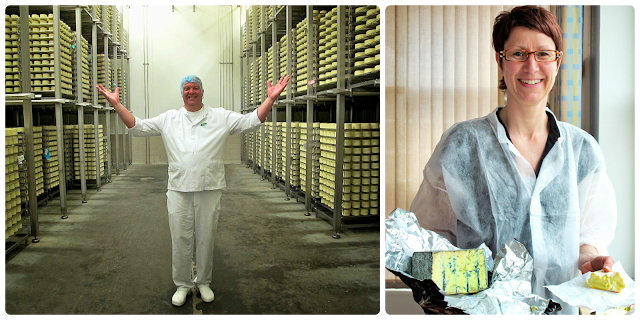 |
| Left: A very proud Bent Hanson who manages the Gjesing dairy. Right: Elise Borregaard, a female cheese maker at Castello. |
Bang in the geographic centre of Denmark, on the Jutland peninsula, lies a city called Aarhus. It’s the smallest place that can still be called a city.
Shortly after Denmark won a historic victory at the Eurovision song contest earlier this year, I went there to visit dairies and to find out more about Danish cheese, particularly Danish blue, the Castello range of soft blue and white cheeses, and the Castello range of decorated cream cheeses.
I was impressed by the dedication of the guys that ran the dairies. They are ruthless about quality; every day each batch of cheese is tasted and if it isn’t up to scratch, it’s binned. Good cheese is expensive to make: in general it takes around six to ten litres of milk to make one kilo of cheese. For Danish blue it takes 515 litres of milk to make 66 kilos of cheese.
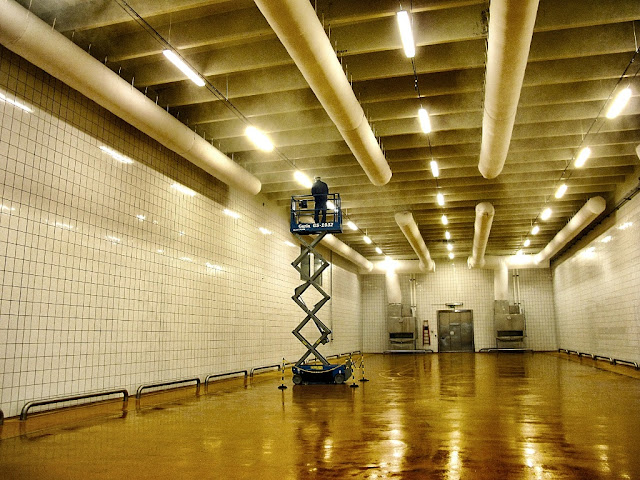 |
| Every 2 or 3 days the entire dairy is cleaned, from the ceiling down. Cleanliness and hygiene is paramount when dealing with dairy. |
What is cheese?
It’s basically preserved milk; the only way of keeping milk for travelling purposes. Michael Pollan in ‘Cooked’ says: “…like many other fermentations, cheese was from the beginning, a boon to mankind: a perishable foodstuff that has been processed in such a way as to render it more digestible, more nutritious, more durable and more flavorful, than the original.”
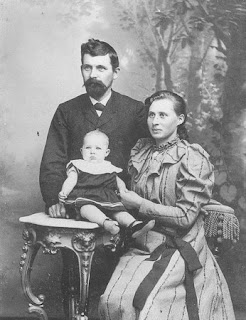 |
| Rasmus Tholstrup himself. |
A brief history of Castello cheeses:
In the blue cheese family tree, Danish blue or Danablu as it’s known in Denmark, is one of the more recent members of the blue-veined dynasty. The earliest is probably Roquefort, of which there are references in literature (Pliny) from AD 79. The British Stilton was created much later, in the 18th century. Danish Blue was invented by Marius Boel in the 1920s when he was trying to make a Roquefort cheese, made out of ewe’s milk, but from cows milk. Production started in 1949 and became part of Arla foods in 1986. It’s now one of the best known and most popular blue cheeses in the world.
Castello Creamy Blue, born in 1893, on the other hand, is more the descendant of the softer, creamier Gorgonzola Dolce (800AD). It was developed by the glamorous Tholstrup family (one of the descendents was married to Roger Moore of James Bond fame) from Denmark who were adventurous travellers. Inspired by Italian cheeses, Rasmus Tholstrup returned to Denmark to make Castello blue cheese.
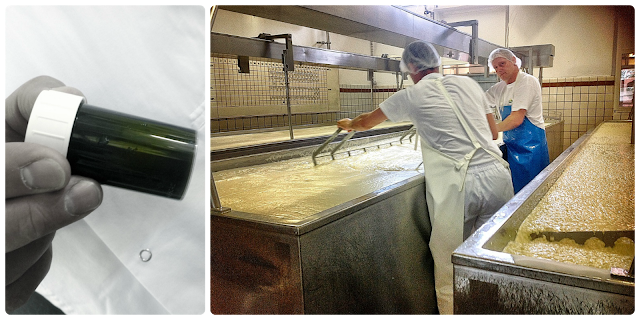 |
| Left: the amount of P. roqueforti needed for one of these huge tanks of curds. |

What are the blue veins on blue cheese?
It’s a kind of mould, but a good mould from the blue mould culture. Just a tiny amount is enough to turn a huge vat of cheese curds into blue cheese after ageing. To aid the process, the cheeses are pierced with stainless steel needles. This ensures a good spread of the blue veins.
You know the white furry ‘skin’ around Brie or Camembert? That’s a kind of mould too.
Mould can be very good for you. It’s the process behind all fermented foods, such as sourdough culture, which is helpful for the gut microbiome.
Penicillin is a mould and it is said, prior to the discovery of penicillin, that shepherds in the Roquefort area used to pack wounds with blue cheese to deter infection.
Moulds, however, in the production of Blue Castello, need controlling. For that reason there is strict quarantine between sections of the Gjesing dairy. The whole factory is air-pressured to prevent outside moulds. Workers must change clothes when they go from a blue mould area to a white mould area.
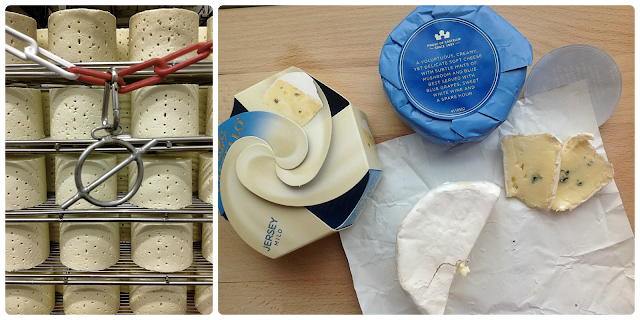 |
| Left: The ø which means this batch is Organic. Right: rich and creamy Castello Jersey blue cheese. |
What kind of milk do they use?
Castello uses cows milk and produces both organic and non-organic cheeses. The milk is homogenised, which is a method of boiling milk. This breaks down the fat globules into smaller more regular cells which improves the texture of cheese. Goats’ and sheeps’ milk naturally have smaller fat globules. Homogenisation also whitens and strengthens the cheese.
Most of the milk is from local dairies in Denmark but the Jersey blue and Jersey white cheeses use the fattier rich milk from Jersey cows.
Some of the ‘Unika’ range of artisan cheeses that Castello make, in collaboration with chefs such as Noma’s René Redzepi, use raw milk. These aren’t yet available in the UK, but I’m hoping!
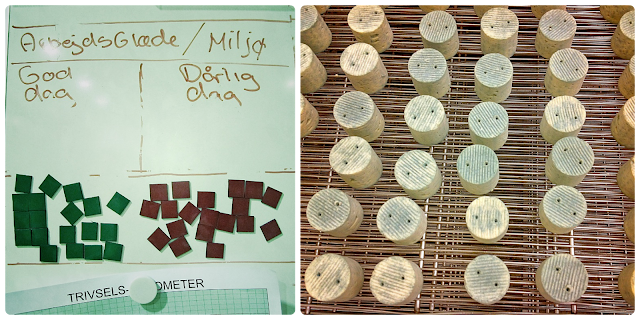 |
| Left: A notice board in the dairy where employees can say whether they had a good day or a bad day. Cute, eh? Right: mini blue cheeses. |
When should I eat blue cheese?
The Danish, Germans and Norwegians are the only nations that eat blue cheese for breakfast. Hardcore! They love it on crispbread and in open-faced sandwiches. But the biggest blue cheese scoffers are the Finns.
It matches very well with sweet wines, champagne and honey.
Blue cheese is served at royal weddings… maybe they will serve it to contestants at the Eurovision song contest next year?
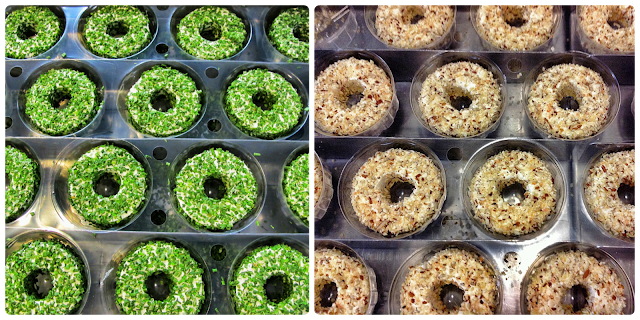 |
| Left: Korsvej Dairy produces: chive covered cream cheese. Right: my favourite – pineapple, papaya and almond cream cheese! |
The popularity of cream cheese varies geographically: for instance Northern Germans won’t eat it but Southern Germans can’t get enough. And cottage cheese sales are going up thanks to the Dukan diet.
I tasted several of the decorated cream cheeses made by Arla. I sneered at the Castello Pineapple Halo, dismissing it as ‘seventies’. But, after tasting it, I loved the unusual flavour and so did my family when I served it on a cheese board, for it disappeared within minutes. The chive encrusted and black pepper encrusted cream cheeses were also good and work well with smoked salmon for instance.Cheese globally:
There are vast parts of the world that don’t eat cheese at all. China is a huge future market as they start to adopt Western diets in addition to their native diets. Like with the discovery of the New World, cultural assimilation goes both ways. They bring us sushi and dim sum, we give them cheese, bread and wine.
Cheeses from Arla are shipped abroad, as opposed to flown, to America, Mexico and Australia.
You may have seen ‘Puck’ in glass jars in the chilled section of ethnic food stores, which is also made by Arla; it sells well in the Middle East as it doesn’t need refrigeration. Puck makes a fantastic dip.
The UK is the biggest market for Danish blue cheese after Scandinavia. We have a sophisticated palette for strong cheese.
 Next post: How to create the perfect cheese board
Next post: How to create the perfect cheese board
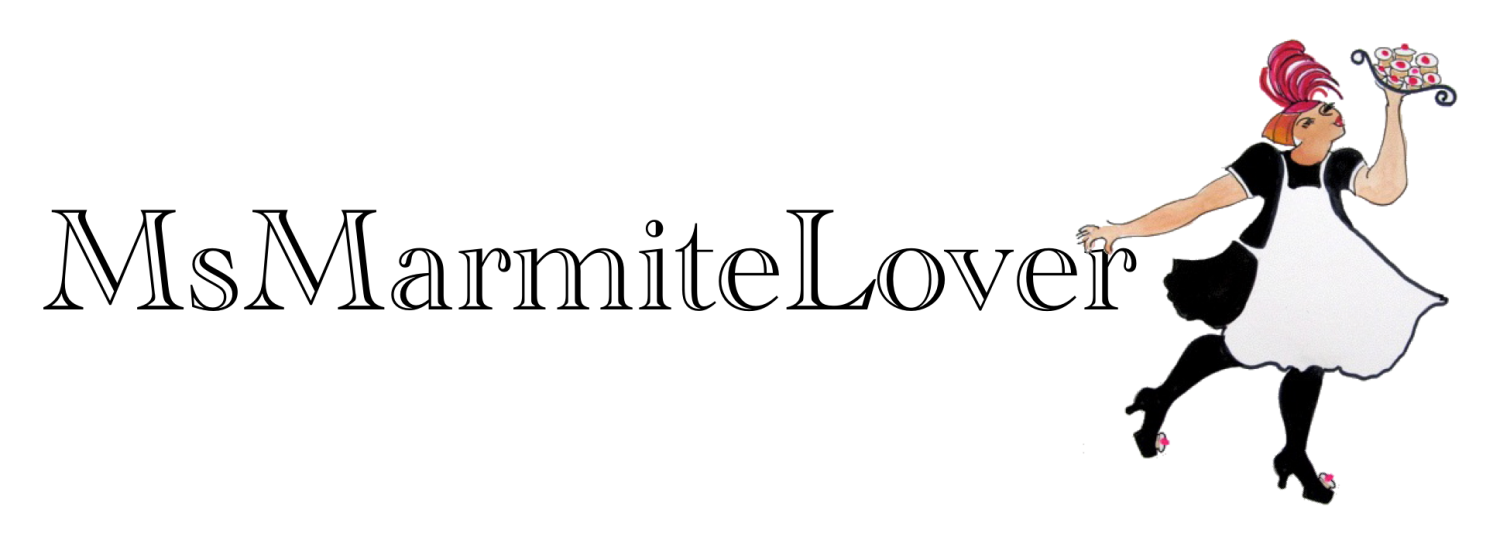

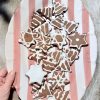

So interesting & I want to try the chive covered cream cheese now. I may have to rethink my commitment to Philadelphia!
I know, I was shocked. Shall definitely be more careful about my cream cheese in future.
Having lived in France for many years, found it fascinating that the P. roqueforti bacteria is used in both Danish Blue and Roquefort. I actually much prefer Danish Blue. Great post.
All blue cheeses stem from the original roqueforti culture. I've got a little bag and I'm going to have a go at making a Kilburn blue cheese!
Lovely pictures MsML!
I've never seen cream cheese so colourful and in the shape of donuts, but I'd be interested to try. I imagine it looked gorgeous on your cheese board 🙂
Hope you are well
Gina
the shape of doughnuts…! Indeed! They do add another good shape to the cheese board as well as tasting pretty good too.
Fascinating, and it's making me properly hungry. Love the photos too.
Thanks North London eater from a Norf Weezy eater!
"They are ruthless about quality; every day each batch of cheese is tasted and if it isn't up to scratch, it's binned. Good cheese is expensive to make: in general it takes around six to ten litres of milk to make one kilo of cheese. For Danish blue it takes 515 litres of milk to make 66 kilos of cheese." Do you really mean 'binned' as opposed to e.g. 'sold on, unbranded, to be retailed as e.g. less expensive cheese/used in cooking or prepared meals/or even, for animal feed?' If not, I really hope they are turning out at least 99% acceptable quality or that's a pretty dreadful waste of milk and all the other resources used to make a batch.
Actually you are right much of the offcuts are used in 'crumble' packages that they sell in Denmark, a bit like smoked salmon off cuts. Very useful and cheaper too.
Other bits are dried and used in cheese flavourings. Personally I'm a big fan of cheese 'powder'.
I love love blue cheeses. Thanks to you I’m going get myself some of the Danish stuff this weekend.
Blue cheese is supposedly healthy for you!
Gosh I had no idea Castello cheese was made in Aarhus, it's where my mum is from!
It's a nice town Aarhus.
after your supper club i bought the pineapple and papaya round cheese. it took a small piece .yum. but when i looked down it had all gone. delicious!
All food with a hole in the middle is slimming imho. Doughnuts, polo mints and round cream cheese. My book on this theory will be published soon I think. I will be famous. And thin.
This blog is a great combination of suitable and useful information for Melbourne Restaurants Here I have found the information for which I was looking for long time.
There are other strains of blue available, but roquefortii is by far the most common. I'm trying to cultivate some of my own blue strains at the moment using mouldy bread at the moment. It's been … interesting!
Kilburn Blue sounds like a great idea, let me know if you need to borrow any equipment or anything. It can get expensive!
Wow that's awesome. And I would like to know the precise definition of 'interesting' within this context!
Yes I would love to borrow equipment!
The vast majority of blue cheese comes from penicillium roquefortii, however there are other strains, such as penicillium glaucum, a slightly greener blue which is used to make gorgonzola. I'm currently trying to grow my own strains the traditional way, by directly inoculating cheese with mouldy bread. It's been … interesting!
Kilburn blue sounds ace, let me know if you need to borrow any equipment, as they can be quite expensive!
Oops, I thought my first comment hadn't gone through and now realised you must moderate comments! Please delete the first one and this one … or all of them, argh! Eejit!
Yes I do moderate the comments because I was getting so much spam. It seems to have more or less stopped now, I guess Google have gotten more efficient. But thanks so much for commenting, great to hear your feedback.
Lets arrange soon for the creation of 'Bleu de Kilburn'.
Great piece; incisive and informative. I love my cheese so I found your article interesting and fabulous. When are you going to do the next one? I need my cheese fix!
AX